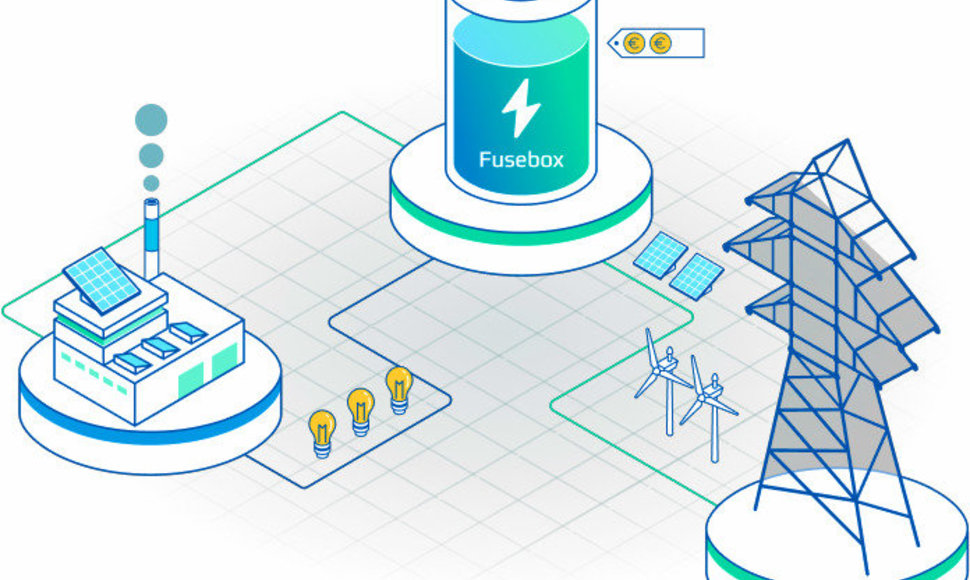Last year, with the Seimas approving changes to the energy law, opportunities opened for independent suppliers unrelated to delivering electricity to consumers to participate in the electrical power balancing market in Lithuania. This has already been possible in Estonia for two years.
“Last autumn, we signed cooperation agreements with the electrical power transfer system operator Litgrid, and the energy company Ignitis, becoming the first independent electrical energy demand suppliers in Lithuania. This February, we will also be launching operations in Latvia, which opened its energy balancing market last year. We intend to soon sign cooperation agreements with energy production companies so that we can provide energy balancing services in this country as well,” says Karolis Kiguolis, partner at Fusebox and the company’s representative in Lithuania.
According to him, the company has a license to offer energy balancing services around the world. Currently, most of the clients on the Fusebox “virtual power plant” network are major manufacturing, industrial, energy, water treatment, real estate management companies, as well as retail networks, in Estonia and Scandinavia.
From this year onward, Lithuanian companies joining the “virtual power plant” network will be offered the opportunity to participate in the energy balancing market and retain their energy consumption flexibility, leaving spare energy capacities for Litgrid to use.
“In Lithuania, we have already signed contracts with the Tauragė heating grid cogeneration power plant, UAB Klaipėdos Šaldytuvų Terminalas, and UAB Nordnix, and we are also due to soon start supplying energy balancing services to the Rimi retail network. Negotiations are currently ongoing with various companies, including those in the industrial sector, who are larger energy consumers and for whom electrical power grid balancing services can bring not only significant financial benefits but also could markedly reduce CO2 emissions. Furthermore, companies participating in balancing will contribute to ensuring the stability of the Lithuanian electrical power grid,” K. Kiguolis continues.
How a virtual power plant works
Around the world, electrical power demand management technologies have been in use for already over eighteen years, but in Lithuania, this remains a new sphere. “Innovative energy balancing technologies have vast potential. Currently, we are the only provider of such services on the Baltic States’ market,” notes K. Kiguolis.
A “virtual power plant” operates akin to a pill that regulates human blood pressure, helping balance the production and consumption of energy generation. At peak hours, when the network has a deficit of energy, the consumption of companies on the network is reduced, while during a surplus of energy, their consumption regime is increased.
By balancing the demand for electricity this way, electrical power producers do not need to turn on extra electricity generating capacities, which are usually powered by fossil fuels. Meanwhile, electrical power consumers, who join a “virtual power plant” and participate in the balancing, receive extra revenue from this and reduced electrical power bills. Furthermore, according to K. Kiguolis, every megawatt-hour saved reduces CO2 emissions by around half a tonne, and so companies on the platform markedly reduce their environmental footprint.
Joining the virtual power plant is free of charge, does not require extra investment, and does not need any extra equipment.
“Every building, regardless of whether it is residential, commercial or for manufacturing, has an electricity and automation system, which if you wish to join the virtual power plant, needs to be renewed so that it can receive signals from the Fusebox virtual power plant. Upon receiving a signal from Litgrid that there is need to balance energy demand, we begin reducing the demand for energy among our clients during peak hours and increase demand when there is excess energy on the market and its price becomes negative,” K. Kiguolis said.
Clients connected to the virtual power plant receive access to the Fusebox network, and can see detailed data and financial results in relation to their participation in the balancing market.
Balancing occurs five to seven times a day and, on average, lasts 15 to 45 minutes. According to K. Kiguolis, this process does not disrupt business processes, and consumers do not even notice its impact. For example, at peak hours a business centre may have its heating reduced by one degree or ventilation decreased. It only takes 30 minutes of reduced energy consumption for the network to see a restored balance.
At the moment, most of the energy balancing services supplied to the Baltic States markets are supplied by Russia, but the region, which seeks to complete energy grid synchronisation with Western Europe by 2025 and take over dispatcher system management rights from Moscow, will see the emergence of a need for energy demand management services, becoming of vital importance.
Green energy also demands innovative energy management solutions, with the green energy sector seeing increasing investment from not only state and privately-owned companies, but also from private individuals who are becoming energy suppliers.
“Green energy sources such as solar and wind power plants are not stable – they supply electricity to the grid at an inconsistent rate. The fluctuating generation of electricity requires help so that the electrical grid will not crash. Electricity balancing services become strategically essential and necessary to ensure the entire power grid’s security,” explains K. Kiguolis. Everyone can participate in energy balancing, ranging from apartment buildings to industrial companies.
Any company can participate in electrical power balancing, regardless of its operations. It could be a shopping centre or apartment building, or it could also be a company dealing in manufacturing or trading. Freezer warehouses have particularly large balancing flexibility capacities.
“The benefits and flexibility obtained by every company from using energy balancing can be calculated after evaluating the equipment it uses, its infrastructure, and the amount of electrical power it uses. We have calculated that 1MW of flexibility can bring a company up to 300,000 euros in revenue over five years,” K. Kiguolis says.
“For example, a retail network whose electrical system flexibility capacity reaches around 3 MW can obtain around 900,000 euros in extra revenue over five years. If such a network were to participate in balancing across the five Baltic States, its savings could reach 3.5 million euros over five years,” the Fusebox representative calculates.
According to Fusebox experts, just the Lithuanian market’s annual flexibility capacity reaches up to 30 million euros – this is the sum that can return to companies participating in electricity balancing.
About Fusebox
The Estonian energy technology start-up Fusebox was founded in 2014. It is the first independent electrical demand supplier, offering energy balancing services across the three Baltic States and Finland. The company’s clients include Estonian Cell, Stora Enso, Tallina Vesi, Vis3L, Nordic Hotels, Rimi, VKG Energia and other major companies in Estonia and Scandinavia.
Fusebox “virtual power plant” projects are also being developed in Poland, Singapore, Sri Lanka, Malaysia, Australia, Brazil, Pakistan and Kenya.
In 2020, Fusebox generated more than 1,000,000 Kwh (1 Gwh) of balanced energy, with companies in the virtual power plant network producing 500 tonnes less of CO2.













